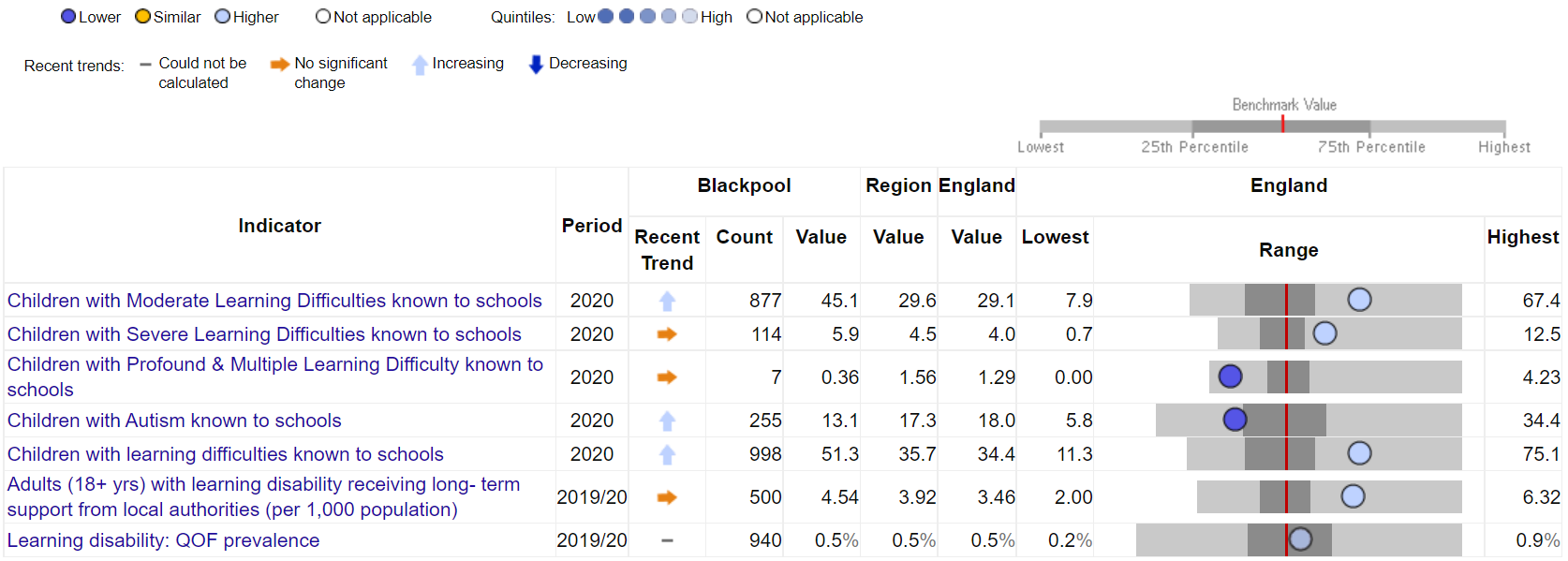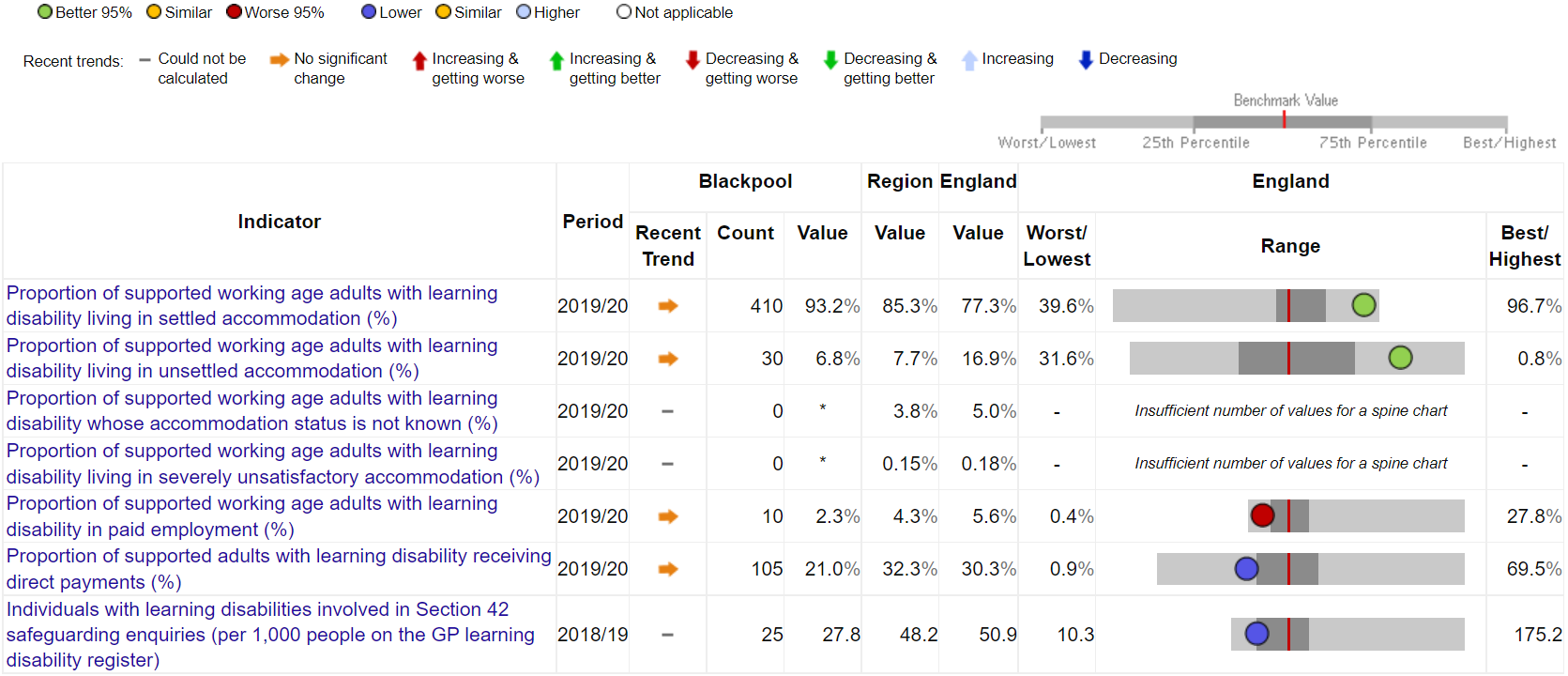Learning Disabilities
Last Modified 16/02/2023 11:30:20
Share this page
Introduction
A learning disability is defined by the Department of Health in its 2001 report 'Valuing People' as:
A significantly reduced ability to understand new or complex information, to learn new skills (impaired intelligence):
-
-
- with a reduced ability to cope independently (impaired social functioning),
- which started before adulthood, with a lasting effect on development
Types of learning disability vary greatly and the challenges experienced vary from person to person. Some people may be able to live independently with minimal support, whilst others may need round-the-clock care and support. The definition of 'learning disability' does not include all those who have a 'learning difficulty' which is more broadly defined in education legislation, and the presence of a low intelligence quotient is not, of itself, a sufficient reason for deciding whether an individual should be provided with additional health and social care support.
Learning disability is one of the clinical priority areas in the NHS Long Term Plan, with a commitment to tackling the causes of morbidity and premature death for people with these conditions1.
For information about children with learning disabilities, see also:
Facts and Figures
Over 1.2 million people in England have a learning disability - an estimated 2.5% of children and 2.16% of adults, though levels of people with learning disabilities recorded in health and welfare systems are much lower2. A 2017 inquiry into premature deaths among people with learning disabilities found that, on average, adults with a learning disability died 16 years earlier than the general population - 13 years for men and 20 years for women, with 31% of deaths caused by respiratory conditions and 16% caused by circulatory conditions3,4. Despite suffering greater ill-health, people with a learning disability often experience poorer access to healthcare.
Covid-19 also had a disproportionately large impact on people with learning disabilities across England. Examining deaths in Spring 2020, Public Health England found that the death rate for people registered as having learning disabilities who died with Covid-19 was 4.1 times higher than the general population, and possibly up to 6.3 times higher, taking into account those who may not be registered. The death rate for people aged 18 to 34 with learning disabilities was 30 times higher than the rate in the same group without disabilities. People with learning disabilities are more likely to have other physical problems such as obesity and diabetes, and certain disabilities, such as Down's Syndrome, can make people more vulnerable to respiratory infections, in turn increasing the risk of dying from Covid-195.
Local and national data about learning disabilities is collated through Learning Disability Profiles by the Office of Health Inequalities and Disparities (OHID) (Figure 1). Key points from local data include:
- Blackpool has a similar prevalence of people with a learning disability compared to England and the North West (0.5% of GP registered patients)
- Blackpool has a significantly higher prevalence of adults with a learning disability receiving long term support from the local authority compared to England as a whole (4.54 per 1,000 population compared to 3.46 per 1,000 nationally). The rate has increased from 3.72 per 1,000 in 2014/15.
- The proportion of eligible adults with a learning disability who have had a GP health check in Blackpool is significantly lower than the England average (44.2% compared to 52.3%)
- In Blackpool 93.2% of supported adults with a learning disability live in settled accommodation, significantly higher than the proportion in England as a whole (77.3%)
- 2.3% of working age adults with a learning disability receiving long-term support from the local authority are in paid employment in Blackpool, compared to 5.6% nationally
- 21% of supported adults with a learning disability receive direct payments compared to 30.3% nationally.
Figure 1 - Office for Health Improvement and Disparities (OHID) Learning Disabilities Profile
Population

Health

Accommodation and Social Care

Coordination and Local Planning

Source: Office for Health Improvement & Disparities - Learning Disabilities Profile
Population projections of the number of people within Blackpool predicted to have learning difficulties in the future are shown in Figures 2 - 5. The number of adults under the age of 65 predicted to have a learning difficulty is expected to fall gradually as the total population in this age group falls over the next 25 years. The number of adults aged over 65 with a learning difficulty is predicted to rise over the period, in-line with the increasing overall population of older adults. Figure 4 estimates that, in 2020, there were 448 people aged 18-64 living in Blackpool who had a moderate to severe learning disability that required the support of local services.
Figure 2 - People aged 18-64 predicted to have a learning disability, by age
| | 2020 | 2025 | 2030 | 2035 | 2040 |
|---|
| People aged 18-24 predicted to have a learning disability |
284 |
267 |
293 |
303 |
286 |
|---|
| People aged 25-34 predicted to have a learning disability |
426 |
416 |
391 |
396 |
428 |
|---|
| People aged 35-44 predicted to have a learning disability |
372 |
393 |
406 |
398 |
377 |
|---|
| People aged 45-54 predicted to have a learning disability |
454 |
390 |
377 |
403 |
417 |
|---|
| People aged 55-64 predicted to have a learning disability |
441 |
464 |
432 |
380 |
374 |
|---|
| Total population aged 18-64 predicted to have a learning disability |
1,976 |
1,929 |
1,899 |
1,880 |
1,882 |
|---|
Source: Projecting Adult Needs and Service Information (PANSI), version 14.2
Figure 3 - People aged 65 and over predicted to have a learning disability, by age
| | 2020 | 2025 | 2030 | 2035 | 2040 |
|---|
| People aged 65-74 predicted to have a learning disability |
331 |
328 |
374 |
403 |
379 |
|---|
| People aged 75-84 predicted to have a learning disability |
197 |
223 |
225 |
236 |
274 |
|---|
| People aged 85 and over predicted to have a learning disability |
69 |
74 |
83 |
99 |
104 |
|---|
| Total population aged 65 and over predicted to have a learning disability |
598 |
625 |
682 |
738 |
757 |
|---|
Source: Projecting Older People Population Information (POPPI), version 14.2
Figure 4 - People aged 18-64 predicted to have a moderate or severe learning disability, and hence likely to be in receipt of services, by age
| | 2020 | 2025 | 2030 | 2035 | 2040 |
|---|
| People aged 18-24 predicted to have a moderate or severe learning disability |
66 |
63 |
69 |
72 |
69 |
|---|
| People aged 25-34 predicted to have a moderate or severe learning disability |
91 |
89 |
84 |
85 |
92 |
|---|
| People aged 35-44 predicted to have a moderate or severe learning disability |
94 |
99 |
102 |
100 |
95 |
|---|
| People aged 45-54 predicted to have a moderate or severe learning disability |
101 |
88 |
86 |
92 |
95 |
|---|
| People aged 55-64 predicted to have a moderate or severe learning disability |
96 |
100 |
92 |
81 |
81 |
|---|
| Total population aged 18-64 predicted to have a moderate or severe learning disability |
448 |
439 |
434 |
431 |
432 |
|---|
Source: Projecting Adult Needs and Service Information (PANSI), version 14.2
Source: Projecting Older People Population Information (POPPI), version 14.2
National and local strategies
The NHS Long Term Plan (2019) recognised learning disabilities and autism as clinical priority areas, with an overall aim to ensure than all people with a learning disability, autism, or both can live happier, healthier, longer lives6. Specific actions included:
-
- increasing uptake of annual health checks for people over 14 with a learning disability
- introducing designated keyworkers for children and young people
- delivering awareness training for staff on supporting people with a learning disability and / or autism
- implementing national learning disability improvement standards across all NHS-funded services
- working with the Department for Education and local authorities to improve awareness of, and support for, children with learning disabilities, autism, or both
- By, 2023/24, reducing in-patient provision to less than half of 2015 levels, supporting more care in the community through new care models and increased investment intended to reduce avoidable admissions and enable shorter lengths of stay
Other guidance material intended to improve and support quality provision includes:
-
- Public Health England Guidance: Learning disabilities: applying All Our Health, March, 2018 - provides information about specific aspects of learning disabilities, their risks and impact, together with core principles, tips for communication and levels of intervention.
- National Institute for Health and Excellence in Care (2018) Learning disabilities and behaviour that challenges: service design and delivery. NICE guideline [NG93] - guidelines for commissioners and providers intended to promote a lifelong approach to supporting people and their families and carers, focusing on prevention and early intervention and minimising in-patient admission.
- National Institute for Health and Excellence in Care (2015) Challenging behaviour and learning disabilities: preventions and interventions for people with learning disabilities whose behaviour challenges. NICE guideline [NG11] - guidance for professionals, commissioners and providers.
[1] Kennedy, S., Long, R., Parking, E., and Powell, A. (2021) Support for People with a Learning Disability. House of Commons Library, 8 June 2021.
[2] Public Health England (2016) Learning Disability Observatory: People with learning disabilities in England 2015: Main report.
[3] University of Bristol, Confidential Inquiry into Premature Deaths of People with Learning Disabilities, Full final report. March, 2013
[4] University of Bristol, The Learning Disabilities Mortality Review Programme: Second Annual Report. December, 2017
[5] Public Health England (2020) Deaths of people identified as having learning disabilities with COVID-19 in England in the spring of 2020.
[6] NHS (2019) The NHS Long Term Plan. www.longtermplan.nhs.uk